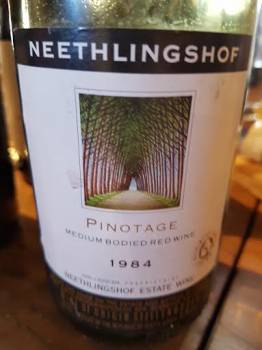Neethlingshof Pinotage 1984
By Christian Eedes, 6 April 2016

4
After presenting his new-release The Owl Post Pinotage 2014 yesterday, Neethlingshof winemaker De Wet Viljoen showed a wine blind to a small group of media and asked us to guess the vintage – it clearly had some age but was by no means decrepit and I guessed 1995, arguably the best vintage of that decade.
It turned out to be the Neethlingshof Pinotage 1984. On the nose, red and black cherry plus some floral perfume to go with more mature notes of leather, earth and spice. The palate meanwhile was pristine, the fruit still amazingly vibrant and intact.
With an alcohol that Viljoen reckons to be just 11.5% and matured in 5 000-litre vats, a wine to make any of the current young gun winemakers smile.
#WinemagRating: 95/100.








Kwispedoor | 6 April 2016
It would be interesting if one could transport a few prominent contemporary wine journalists/commentators to 1986 to taste this wine and rate it. It would be equally interesting to jump in another time machine and end up somewhere between 2044 and 2048, where they could taste some of the plush, ripe red wines scoring 92+ points in recent times. Modern society’s obsession with immediate gratification is not doing fine wine much favours, whatever other benefits it might have brought to wine in general.
A wine lover | 7 April 2016
Similarly, it would be interesting to climb into that same time machine and go to 2044 and taste these light, fruity, stemmy, low alcohol, “red wines for white wine drinkers” wines that are so fashionable now and see how they have fared 30 years into the future.
I submit that these cool, light reds are pandering even more to the desire for instant gratification, and the commercial imperative of early sales more than the wines you criticize. The sleight of hand their producers have pulled off is convincing people who should know better that they are intrinsically more honest, more honorable than wines made in a different style, a style many people enjoy, but you, evidently, do not. Thank goodness some of these producers don’t have the herd mentality prevalent in so many so called “new wave” winemakers.
Christian | 7 April 2016
Hi Wine Lover, I think you make a timely point. Wine greatness will surely always depend on the fundamental traits (sweetness, acidity, alcohol and tannin) being in balance. In particular, the current preoccupation with whole bunch fermentation is leading to a lot of greenness and rusticiity which is being excused in the name of freshness.
Kwispedoor | 7 April 2016
You assume a lot, Wine Lover… I haven’t met anyone yet that loves such a variety of styles and cultivars as I do. I’ve got nothing against fuller wines and plan to drink one tonight in this freezing winter we have in Gauteng.
Let me try and clarify my earlier comment. I would guess that that 1984 Pinotage, at two years of age, might possibly have shown a bit of so-called “old-style” Pinotage characteristics in its youth that would not have gone down too well if it was rated then by someone used to the way that most modern wines taste in its youth today. It would have had a completely different tannin structure as well, being harvested at a sugar level that only yielded 11.5% ABV. A touch of “greenness” (horror of horrors!!!) might also have been part of the package, or not, at said ripeness levels. I’m just guessing it would not have steam-rollered to 95 points. Actually, I just checked my 1989 Platter and it gets a measly two and a half stars – “Full ruby colour, fruity nose, more mulberries than pinotage esters, fair dose of tannin rather overwhelms fruit in ’84 (**(*)). 18 months in big wood.”
Conversely, there is no track record for ripe, smooth-tannined SA reds after three decades+ maturation. I can, however, remember wines like a Rupert & Rothschild Baron Edmund (I’m not sure, but it might have been a 2005 that weighed in at 15% or 15.5% ABV in the years that Michel Rolland went ballistic there) that we had at a blind tasting. It did fairly well on the tasting, but nobody could drink it afterwards. I wonder how that will show in another two decades? Luckily, R&R have mostly deserted that style by now. The very ripe wines also have very high pH levels, which doesn’t exactly help Sulphur to control brett as time goes by in the bottle.
I guess I was partly saying that we often underrate good wines that don’t shine when they’re young, while most winemakers strive to make wines that are drinkable early. And I don’t know if that’s the best thing for longevity. Judging potential in a wine is more difficult than anything else in wine assessment. And thin & weedy wines are just as bad. Balance is key.